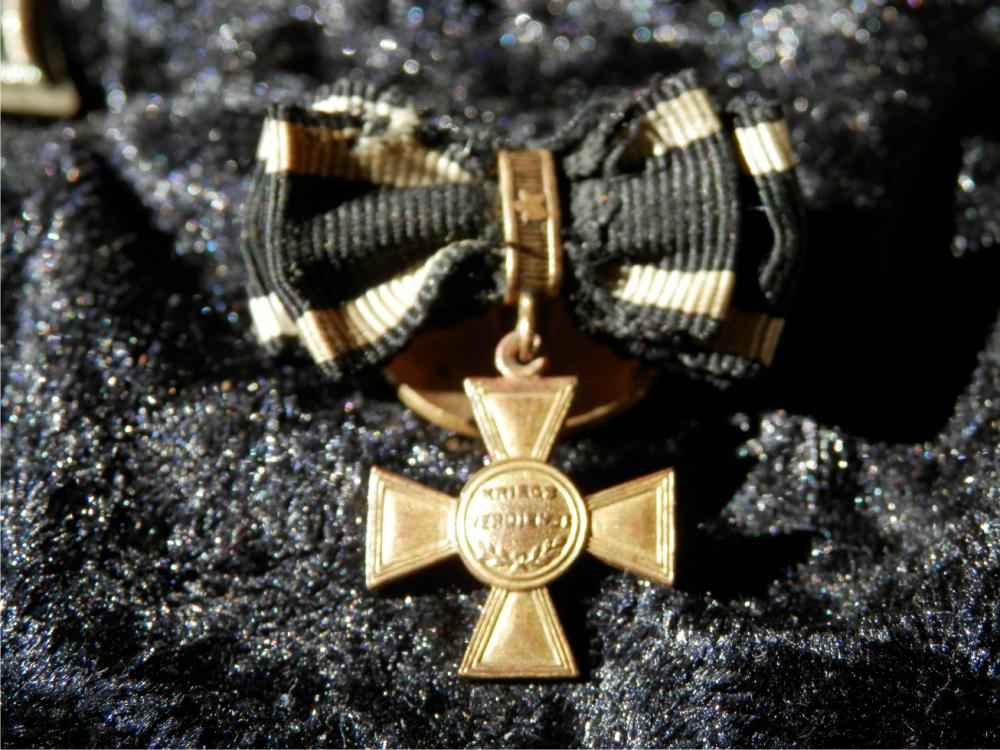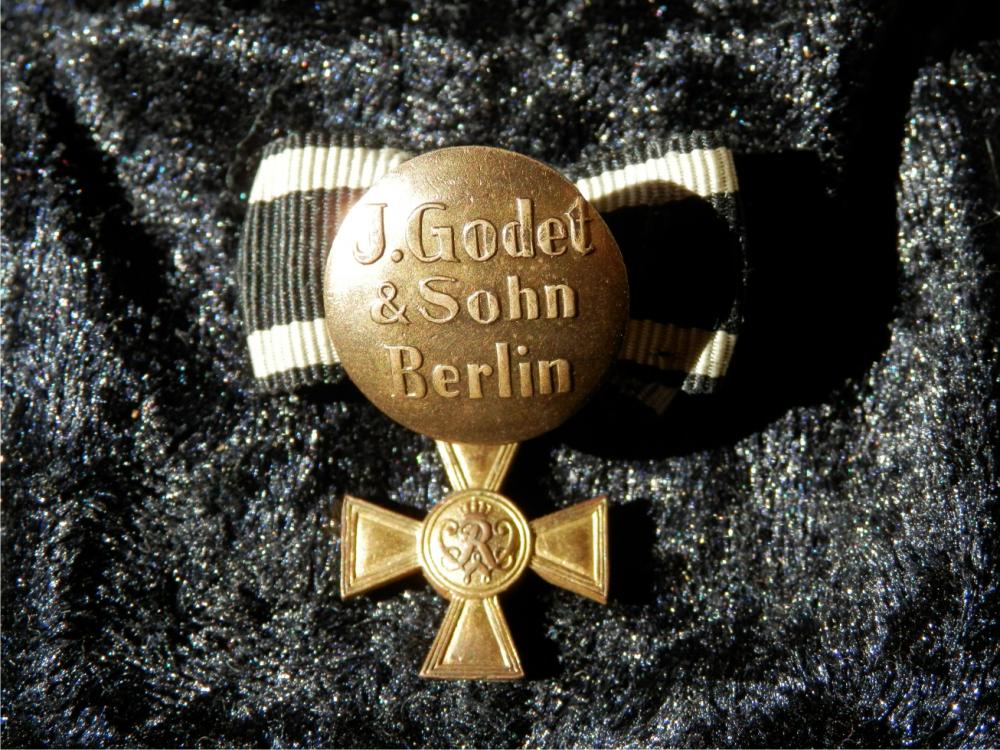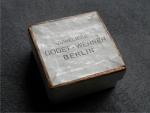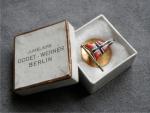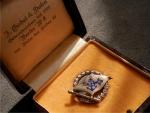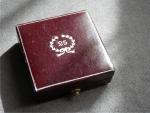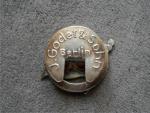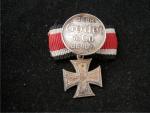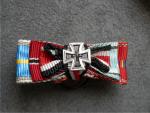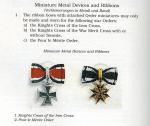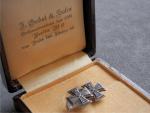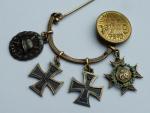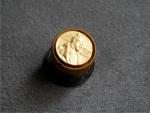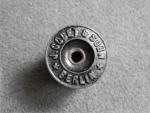-
Posts
237 -
Joined
-
Last visited
Content Type
Profiles
Forums
Blogs
Gallery
Events
Store
Everything posted by kasle
-
I have a simple question to which I can´t find simple answer. When I tested ribbons under UV light in the past, it was always quick and decisive: positive ribbons are modern fakes, negative ribbons have a chance to be original. It is always useful mainly with EK ribbons, where white on modern fakes brightly glows electric blue But what to think about ribbon where white (as a basic colour of the material) doesn't glow, but red stripes glow orange? It happened with 4-piece ribbon bar, where three ribbons (EK2, Kroneorden, Zentenarmedaille) are UV negative, but the last one (Turkish war medal) gives results mentioned above. Last ribbon shows no signs of being added lately, and it is sewn with same thread as all other ribbons. All ribbons are worn same way and to me it looks that the ribbon bar has correct hardware. Same thing hapenned to me in the past with 2er ribbon bar (EK2 and Hessian Tapferkeit), which looked very convincing with both ribbons heavily worn, and with white colour on Hessian medal absolutely UV negative - just red stripes were glowing orange. That time I deemed the bar as fake and forgot about it, but now I think it is worth question. Maybe it is silly question, but what do we test under UV lamp? UV-behaviour of material or of colours on it? Thanks in advance for any opinion.
-

EK 1870 1914 clasp to a 1870 EK opinion
kasle replied to larsb001's topic in Germany: All Eras: The Iron Cross
Try this http://www.medalnet.net/iron_cross_1870.htm Article starts with original pieces, but ends up with description of Ninth Bead Fake. -

EK 1914 The KO debate revived.....
kasle replied to Chris Boonzaier's topic in Germany: All Eras: The Iron Cross
If you know the company history, many things clear up very quickly. Company started in 1904 as a small firm, but very quickly, in 1906 it became a manufacture employing 80 workers, involved in producing chains, watches and ladies jewelry mainly for export (USA, etc). They lost these markets with the outbreak of ww1, but they quickly reoriented to production of military awards. Alfred Quenzer died already in 1918 (some sources say 1917). Company led by Robert Klein only, was for a certain time named Klein, Oberstein. It would be good to add at this time, that Oberstein became Idar-Oberstein only after first administrative reform of Third Reich in 1933, when smaller municipalities of Idar, Oberstein, Tiefenstein and Algenrodt became one town. Only in 1928 Klein & Quenzer Aktiengesselschaft (AG) was founded, with shares in hands of Robert Klein and company Kollmar & Jourdan Pforzheim. In this time new factory was built which employed 300 workers. Robert Klein died as old man in 1940. It means that during the "nicest era" of 1939 EKs company was led by somebody completely else (Robert Stein and Alfons Schmidt) than during "ugly era" of EK 1914, in another form (AG) and producing in another, "modern" factory. At that time, Klein & Quenzer was only a trademark. Knowing this facts, I am not supporter of Klein & Quenzer AG, Idar-Oberstein theory, being producers of KO crosses. For me it was Klein, Oberstein. Klein probably returned to the Klein & Quenzer name only when EK production ceased and it was not from nostalgy. He just wanted to return to "civilian" international market under the same name as they used in prewar time and started to sell watches. chains and ladies jewelry as "good old" Klein & Quenzer. I think it was quantitative theory, not trial and error method that led to this connection. It is known, that Klein (& Quenzer, if you want) produced many EKs in 1917 - 1924 era, but it is not surely known which ones. On the other hand, there are many EKs marked KO from unknown maker. There is no other big producer, whose crosses we don´t know, and there is no other huge amount of EKs, that have no maker identified. If I remember correctly, it was Wernitz who found the order for 13.000 EK1s addressed to Klein, Oberstein company shortly after war. -

EK 1914 The KO debate revived.....
kasle replied to Chris Boonzaier's topic in Germany: All Eras: The Iron Cross
Jakob Kling - Goldwarenfabrik und Grosshandlung. Gold ware company and Wholesale company. Sorry Chris, you didn´t convince me yet. I think that someone (KO) who produced 1,5 mil. crosses just had to have some distributors. Further in the label, Jakob Kling advertises himself as a specialist for: juwelen (jewelery), ketten in allen qualitäten (chains in all qualities), rings, traurings (wedding rings) and Alpacca waren (Nickel-silver ware). To me it looks like distributor trying to catch another "bird" by advertising his own "civil" products. From producer, I would expect at least word about ordensjuwelen, ordensketten or ordensspangen. CFZ produced crosses for Godet & Co. What do you see on envelopes, etuis (and carton boxes, I suppose)? Godet & Co all the way. In this case even the crosses are marked (if marked) with Godet&Co numbers. Another example - Fr. Sedlatzek. I agree this pic is a food for thought. But before discussion take off, we should make ourselves sure that we stay on solid ground. Otherwise we are only cleared for wishful thinking. -

EK 1914 The KO debate revived.....
kasle replied to Chris Boonzaier's topic in Germany: All Eras: The Iron Cross
According to the text in the back of the photo, this is distributor´s label: "A cardboard box with retailer name of Jakob Kling from Mannheim containing thirty second class iron crosses made by the company Koenigliches Muenzamt Orden Berlin" Which means Mr. Baldwin in this book is on - or just repeats - obsolete Muenzamt theory side. -

EK 1870 1914 clasp to a 1870 EK opinion
kasle replied to larsb001's topic in Germany: All Eras: The Iron Cross
Cross is notorious Ninth Bead fake, for sure. The 25 jubileum clasp is not good as well. I can´t comment on 1914 clasp, but in ths configuration I wouldn´t put any hope in it. -
No, it is empty case for civilian honour badge 25 years of service for Norddeutscher Lloyd Bremen (see below). The only difference between these two cases (the case in this post is not the same as the one in previous) is address - Unter den Linden 12 and 53. Which means contract (and production) of this badge lasted for quite a long time. Badges are identical in both cases. I just bought "53" version empty, so I use it for displaying another Godet buttonhole mini which belongs to the same era. But cases for military buttonhole minis by Godet do exist as well, in many variants.
-

EK All Eras Iron Cross Minis - Three Wars Worth
kasle replied to Brian R's topic in Germany: All Eras: The Iron Cross
Buttonhole minis started at the end of 19th century as Prinzen sizes, mostly. Very quickly they switched to dangling minis (at the beginning of 20th century). Same "buttonhole revolution" came at the beginning of 1930s. New fashion was fixed minis at the top of the buttonback - with or without ribbon, singles, doubles or couples, mounted side by side or one on top of another. These types are known also from older times, but only in 30s they won the customer´s interest definitely. Dangling minis didn´t ceased absolutely, we can see them from time to time on later Godet buttons as well, not only on veteran imperial pieces (Prussian MVK), but also on buttonbacks of awards instituted in TR era (Olympia Ehrenzeichen). From these facts we can assume, that there was no strict rule forbidding this or that in area of buttonbacks (until LDO). It was just fashion, natural development of style in process of use, with its own unofficial rules and this fashion clearly started before institution of 1939 awards. When they came, their wearing style was logically influenced by actual (to that date) fashion of wearing ww1 veteran and prewar awards. Until it was regulated by LDO. -

EK All Eras Iron Cross Minis - Three Wars Worth
kasle replied to Brian R's topic in Germany: All Eras: The Iron Cross
And here is one very official RK mini, as seen on previously posted scan from Doehle´s book. Just the condition is worse. This piece was found in Zimmerman hoard, ribbon was added by me for display. -

EK All Eras Iron Cross Minis - Three Wars Worth
kasle replied to Brian R's topic in Germany: All Eras: The Iron Cross
Here is 57 version of EK1 buttonhole mini. Wearer is known (Lt. Lerchner) and he was awarded with Iron cross 1st class. -

EK All Eras Iron Cross Minis - Three Wars Worth
kasle replied to Brian R's topic in Germany: All Eras: The Iron Cross
If I remember the (unofficial) rules completely - Only ribbon bow = EK2, Ribbon bow with EK mini on the top = EK1 (version with two EKs on top is known as well), Ribbon bow with dangling EK mini = Ritterkreuz. In 1942 these rules became more strict (no buttonhole minis except highest awards), but in 1957 version we can sometimes see comeback of previous unofficial rules. The allowed and prohibited types of buttonhole miniatures are explained nicely in the final (1945!) edition of Dr. Doehle's "Die Auszeichnungen des Großdeutschen Reiches", which is available as a reprint. Doehle: Die Auszeichnungen des Grossdeutschen Reiches, ISBN 3931533433 -

EK 1914 Bulgarian soldier with EK .....
kasle replied to Chris Boonzaier's topic in Germany: All Eras: The Iron Cross
Zemlyanka a mi na glavnata... Zemlyanka (probably the cabin in behind) and us at main... Can´t read the last word from first line. Ufortunately,I can´t break the handwriting code in second line, except the last two words "I chudozhnika"...and artist. -
What´s wrong with Google? "The term "Wissmanntruppe" was used for the military and police units under Major Wissmann's command. They formed the core of the later Schutztruppe which came into life after the German government took over East Africa from the failed company." http://en.wikipedia.org/wiki/Hermann_Wissmann
-
Not at all. Nice cross anyway.


